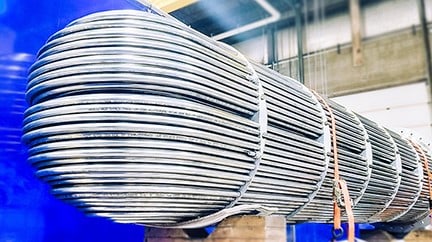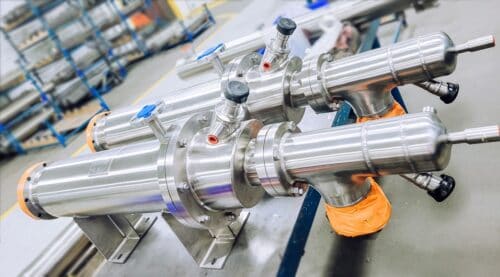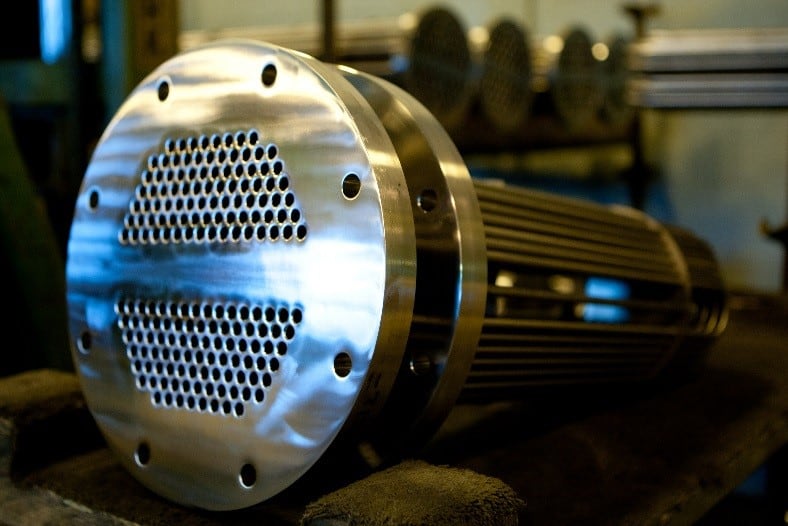With so many factors to consider in choosing a material for your shell and tube heat exchanger, you may have a lot of questions. To start, you’ll need to decide which criteria are most critical to your operation. Criteria like:
- thermal efficiency
- cost
- availability
- corrosion resistance
- cleanability
- durability
You can then weigh the pros and cons of the options that best meet your priorities, since there is typically more than one good alternative. For example, the best material for heat transfer may not be sanitary enough for your application; or the most corrosion-resistant option may far exceed your budget. In most cases, there is a heat exchanger material option that can balance most of your priorities.
Here are a few tips and suggestions for evaluating the heat exchanger material options based on these common criteria.
Thermal Efficiency
Since the goal of a shell and tube heat exchanger is to transfer as much heat as possible between the product (typically in the tubes) and the utility fluid (typically in the shell), the thermal conductivity of the tube material is a key factor. Based on thermal modeling comparisons using HTRI software, copper and copper/nickel are typically the most conductive material available for exchanger tubes. Carbon steel, stainless steel, and higher alloys are slightly less efficient, but all perform similarly. Plastics, graphite composites and ceramics are the least conductive materials available.
Thermal performance can also be enhanced through modification to tubes, such as corrugating, adding external fins to the tubes, or by adding twisted tape turbulators to the inside of the tubes. However, because thermal performance among metals is so similar, this is not usually a high priority factor in heat exchanger material selection.
Cost & Availability

U-tube water cooler built with 2205 Duplex tubes – an austenitic-ferritic stainless steel that stands up to chloride stress corrosion.
Material pricing and availability can fluctuate based on market supply and demand, the quantity required for your exchanger, and the components needed. Copper was a low-cost option a few years ago, but now due to supply, it is more expensive than stainless steel. Conversely, Titanium used to be one of the most expensive alloys but is now more reasonably priced. Typically, the more nickel content in a metal, the higher the price.
Here is the relative ranking for some of the common metal material options by price from highest to lowest:
1. MOST EXPENSIVE: Nickel 200, also known as UNS N02200, is a commercially pure nickel alloy. It is one of the most widely used nickel alloys due to its excellent mechanical properties and high corrosion resistance. Nickel 200 consists of 99.6% pure nickel, with small amounts of impurities such as iron, copper, and manganese.
2. Alloy 625, also known as Inconel 625, is a nickel-based superalloy known for its excellent strength, corrosion resistance, and high temperature performance. It is composed mainly of nickel, with significant amounts of chromium and molybdenum, along with smaller additions of niobium, iron, and other elements. Alloy 625 is widely used in various industries, including aerospace, chemical processing, oil and gas, and marine applications.
3. Monel 400 is a nickel-copper alloy known for its excellent corrosion resistance in various environments. It is composed of approximately 67% nickel and 30% copper, with small amounts of iron, manganese, carbon, and silicon. Monel 400 is highly resistant to corrosive substances such as acids, alkaline solutions, and saltwater. It is often used in applications where resistance to corrosion, erosion, and high temperatures are essential.
4. Hastelloy C22 is a nickel-chromium-molybdenum alloy known for its exceptional corrosion resistance in a wide range of aggressive environments. Hastelloy C22 is particularly resistant to pitting, crevice corrosion, and stress corrosion cracking. Hastelloy C22 is often chosen for chemical processing and waste treatment.
5. Hastelloy C-276 is a nickel-molybdenum-chromium alloy that is renowned for its corrosion resistance and high-performance properties. While similar to Hastelloy C22, Hastelloy C-276 has lower chromium content, easier weldability, and slightly higher upper temperature limits. Hastelloy C-276 is used in various industries, including chemical processing, pollution control, pulp and paper production, and petrochemical applications.
6. Duplex 2507 is a super duplex stainless steel alloy that offers excellent strength, corrosion resistance, and durability. It is part of the duplex stainless steel family, which combines the desirable properties of both austenitic and ferritic stainless steels. Duplex 2507 is characterized by its high levels of chromium, molybdenum, and nitrogen, providing superior resistance to corrosion and high mechanical strength.
7. AL6XN is a high-performance austenitic stainless steel alloy that offers exceptional corrosion resistance and mechanical properties. It is specifically designed to withstand highly corrosive environments, including chloride-rich environments, acids, and seawater. AL6XN is known for its versatility, making it suitable for various applications in industries such as chemical processing, pulp and paper, oil and gas, and desalination.
8. Titanium is a lightweight metal known for its high strength, low density, and excellent corrosion resistance. Titanium is widely used in various industries due to its unique combination of properties.
9. Duplex 2205 is a stainless steel alloy with a combination of austenitic and ferritic microstructures, known as a duplex structure. It offers excellent strength, corrosion resistance, and durability, making it suitable for a wide range of applications. Duplex 2205 is highly popular in industries such as oil and gas, chemical processing, marine, and pulp and paper.
10. 316L stainless steel is a commonly used grade of stainless steel known for its corrosion resistance, high strength, and versatility. It is an austenitic stainless steel alloy with low carbon content, making it suitable for various applications where resistance to corrosive environments is essential. It is widely used in marine applications, chemical processing, dairy, and pharmaceuticals.
10. 304L stainless steel is a commonly used grade of stainless steel known for its corrosion resistance, versatility, and ease of fabrication. It is an austenitic stainless steel alloy with low carbon content, which enhances its weldability and reduces the risk of sensitization to intergranular corrosion. In comparison to 316L SS, 304L SS has no molybdenum content and it’s less resistant to chloride-induce corrosion. It is suitable for general-purpose uses that don’t require the enhanced corrosion resistance of 316L SS.
12. LEAST EXPENSIVE: Carbon steel is a type of steel that primarily consists of iron and carbon, with other elements present in smaller amounts. It is one of the most commonly used materials in the manufacturing and construction industries due to its affordability, strength, and versatility.
Typically, the higher priced alloys are also in shorter supply, due to lower demand and the higher cost of carrying inventory. This directly affects the lead-time of these materials, often by 2-4 times that of more common alloys like carbon steel and stainless steel. Quantity of these higher alloys can also greatly affect price. Steel mills typically don’t run small batches of tubes or plate or they will charge for the entire mill run if they do.
Shell Side and Tube Side May Be a Combination of Materials
The shell side and tube side of an exchanger can be built from different materials of construction. It is common to use amore corrosion-resistant and/or sanitary alloy for the product side of the unit, while using a lower grade alloy for the utility side of the exchanger.
If a higher alloy is the material selection, it is more economical to use it on the tube side of the unit instead of the shell side. However, be aware that for tubing, seamless tubes are almost double the price of welded type tubes, so this should be considered as well. You may find that seamless 316L stainless tubes cost more than welded Duplex 2205 tubes, for example.
Common parts such as fittings are less likely to fluctuate than raw materials like plate stock, tubing and forgings. There are ways to help reduce cost when using higher alloy components. Consider lap-joint flanges, where the product contact nozzle (stub end) is high alloy, while the flange is stainless or carbon steel. These also aid in ease of installation, ensuring bolting alignment with existing, mating piping or equipment. Larger parts like tubesheets, flange rings and channel covers can often be made from a lower alloy base material that is clad with a thinner layer of high alloy to reduce cost.
Supplier Resources
Another factor to consider when evaluating the various alloys is the number of suppliers that work with these materials, since this can affect cost and delivery. There are many fabricators that build exchangers from carbon steel and copper, so competition is high, prices are low, and lead-times are generally fast. There are fewer suppliers that work with the alloys from 304/304L SS up through the Incoloy series, but enough to keep prices and lead-times reasonable. Fabricators must have ASME compliant weld procedures for these alloys to provide pressure vessels such as shell and tube exchangers, which are classified as National Board Registered pressure vessels. Not all fabricators have these procedures for all materials, so it is wise to verify your preferred fabricator’s capabilities when considering alloy options.
Since Titanium, Zirconium and Tantalum require specifically controlled environments for fabrication, supplier options are more limited. This specialty niche can be expensive with longer lead-times, so these materials are normally only used when applications require nothing less.
Dispelling the carbon steel is cheaper myth: For most small and mid-sized exchangers up to 24 inches in diameter, it can be less expensive to upgrade carbon steel shells to a material selection of 304 stainless steel. Although the material cost is a bit higher for the stainless per foot, stainless eliminates the labor cost for priming and painting the exterior, which typically offsets the material cost difference. This, combined with reduced maintenance costs and added durability, makes stainless a better long-term value.
Corrosion Resistance

This custom pair of wiped film evaporators were built for a hemp processing application. Their 304L stainless steel straight tubes were bright annealed to reduce surface oxidation.
If corrosion resistance is critical for your application, it is best to consult a metallurgist to discuss the operating conditions and request their recommendation. Most reputable high alloy providers have metallurgists on staff. Rolled Alloys has proven to be a good resource, with responses and recommendations provided within 24 hours. Corrosion resistance charts can also be helpful for less critical applications where corrosive element concentrations are low.
Many people are not aware that carbon steel is not only corrosive itself but can cross-contaminate stainless and higher alloys and cause them to rust, which is why Enerquip’s shop in Medford, WI is 100% carbon-free. It’s also why it’s not a good idea to use regular steel wool to clean your stainless sinks and silverware, as it will cause rouging. The same affect can be seen in heat exchangers containing carbon steel parts. Rust from carbon steel parts will attack the higher alloy parts of your equipment, potential causing premature failure. However, there are also cases where carbon steel offers better resistance to stress corrosion cracking than stainless steel, so the risks of rust corrosion need to be weighed against stress corrosion cracking during material selection. Enerquip’s carbon steel equipment is built proudly in Beggs, OK.
Copper and CuNi have moderate corrosion resistance but tend to discolor and scale easily. These softer materials are commonly used for shell and tube exchangers in utility applications, where the non-sanitary tube material and carbon steel shells do not create a product contamination issue.
Stainless steel has become a very common heat exchanger material selection for low to moderate corrosion resistant applications. Since 316L SS is more corrosion-resistant than 304L SS, it is often selected for the tube side of an exchanger, while the shell is made from 304L SS. If additional corrosion resistance is needed, then the Duplex stainless series (2101, 2205, or 2507) is considered. Continuing up the ladder of corrosion resistance AL6XN is followed by Hastelloy alloys C-276, C22 and C2000. For higher corrosion resistance, Monel 400 and Alloy 625 are considered, before evaluating the extreme corrosion resistance of Titanium, Zirconium and Tantalum. Note: Each alloy has a specific resistance level to specific chemicals or solutions, so it is best to consult with a metallurgist during the selection process to match your process with the proper material.
Cleanability
If ease of maintenance and integrity of your product quality are high priorities, then materials that are easier to clean and maintain should be selected. The materials must stand up to your preferred cleaning regimen – whether it be chemical, mechanical or ultrasonic cleaning (or a combination). Acids, caustics and chlorides are common in cleaning solutions, but can be harmful to metals in higher concentrations or elevated temperatures. Once you decide on a material of construction, companies that provide these cleaning chemicals, like Ecolab or AFCO, can provide recommendations on concentrations that are suitable.
Sanitary Markets Require Stainless
In sanitary industries such as food, beverage, dairy, pharmaceutical and cannabis processing, product contact surfaces must be stainless steel or a higher alloy, and cleanable, to comply with strict guidelines such as FDA, ASME BPE or the 3-A Sanitary Standard. Because the surface finish of the material impacts its cleanability, these industries require product contact surfaces to be polished to a specific Ra (roughness average) for food, beverage and dairy, and for pharmaceutical applications.
Some pharma applications also require electropolishing, which removes a very thin layer of material, aiding cleanability further. Smoother material surfaces also resist build-up and scaling on both the product and utility side of an exchanger. Therefore, many companies avoid carbon steel and copper, which can become more porous as they corrode, encouraging scaling and fouling.
Durability
For situations where durability is not a high priority, low cost, catalog type heat exchangers constructed from copper and carbon steel may be appropriate. Many HVAC applications fall into this category, where replacing parts from time to time is normal and acceptable. However, in production facilities, where process equipment is pushed to its limits on an ongoing basis, durability is much more critical. Equipment failures can contaminate product, stop production and even be dangerous.
It is important that the material selected for your heat exchanger meets ASME Code requirements and can operate for an extended time at your operation’s design pressures and temperatures. The materials must withstand your cleaning regimen and environmental factors such as moisture, dust, and temperature extremes.
In situations where dissolved solids and high tube velocities can take their toll on heat exchanger parts, it makes sense to use materials that are erosion resistant. When carbon steel and copper exchangers are designed, ASME Code requires a corrosion allowance be added to the material thickness. This is added to account for anticipated corrosion and loss of material thickness over time. These exchangers may also include anodes that corrode away before the exchanger parts do. These can be monitored and replaced periodically. When higher alloys are used in place of carbon steel and copper, these corrosion allowances are no longer required, resulting in thinner, lighter materials in a more durable piece of equipment. Stainless and higher alloys do not require painting to protect their exterior finish from corrosion, so there is no flaking and peeling paint to contend with, decreasing maintenance time and expense.
The experts at Enerquip are happy to assist you by providing options for your shell and tube heat exchanger materials of construction. We work in many alloys and can provide suggestions and feedback to help narrow down your choices based on priorities. For more unique cases, we may refer you to credible metallurgists who can help you finalize your heat exchanger material selection.
Click here to learn more about Enerquip’s custom exchangers.

